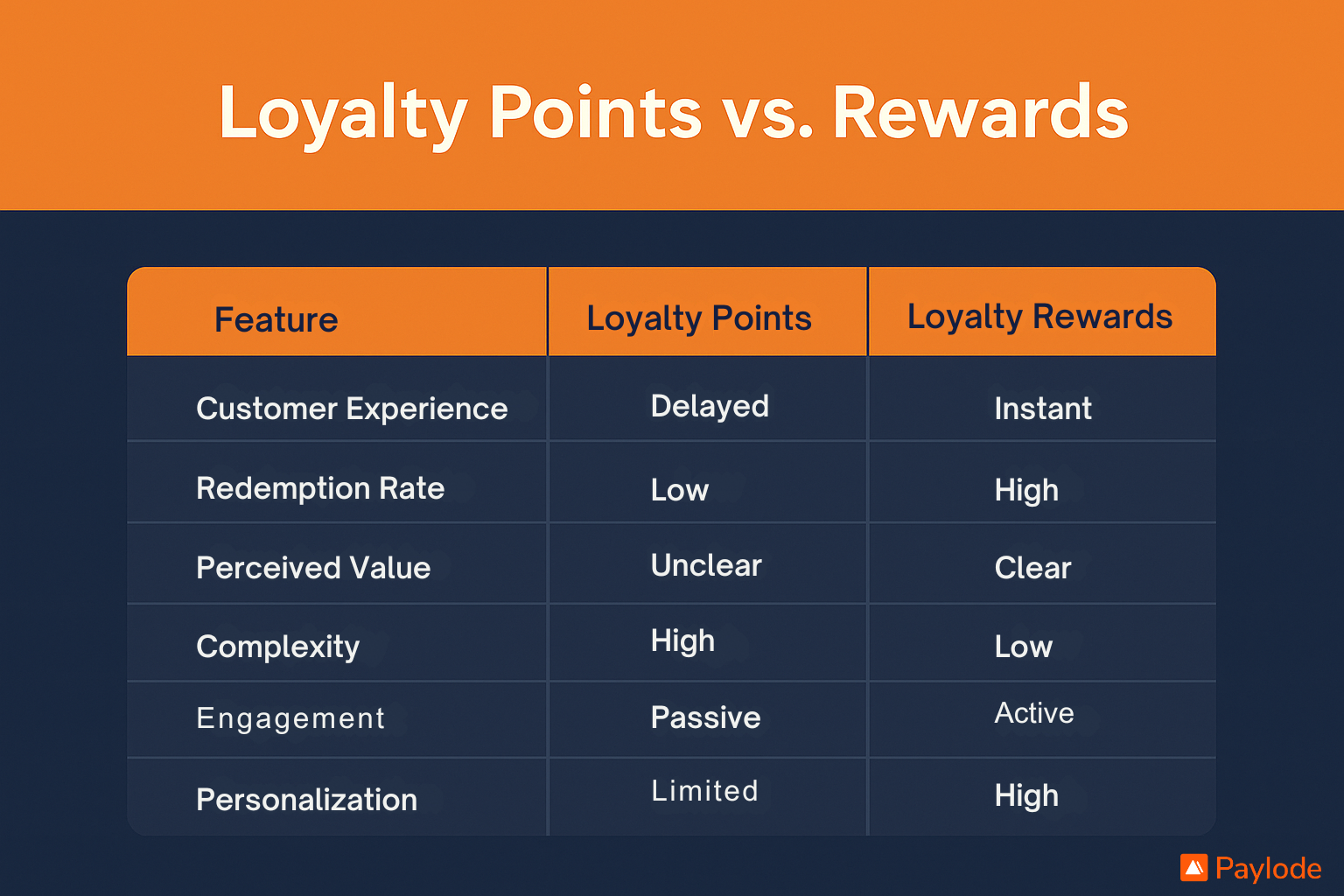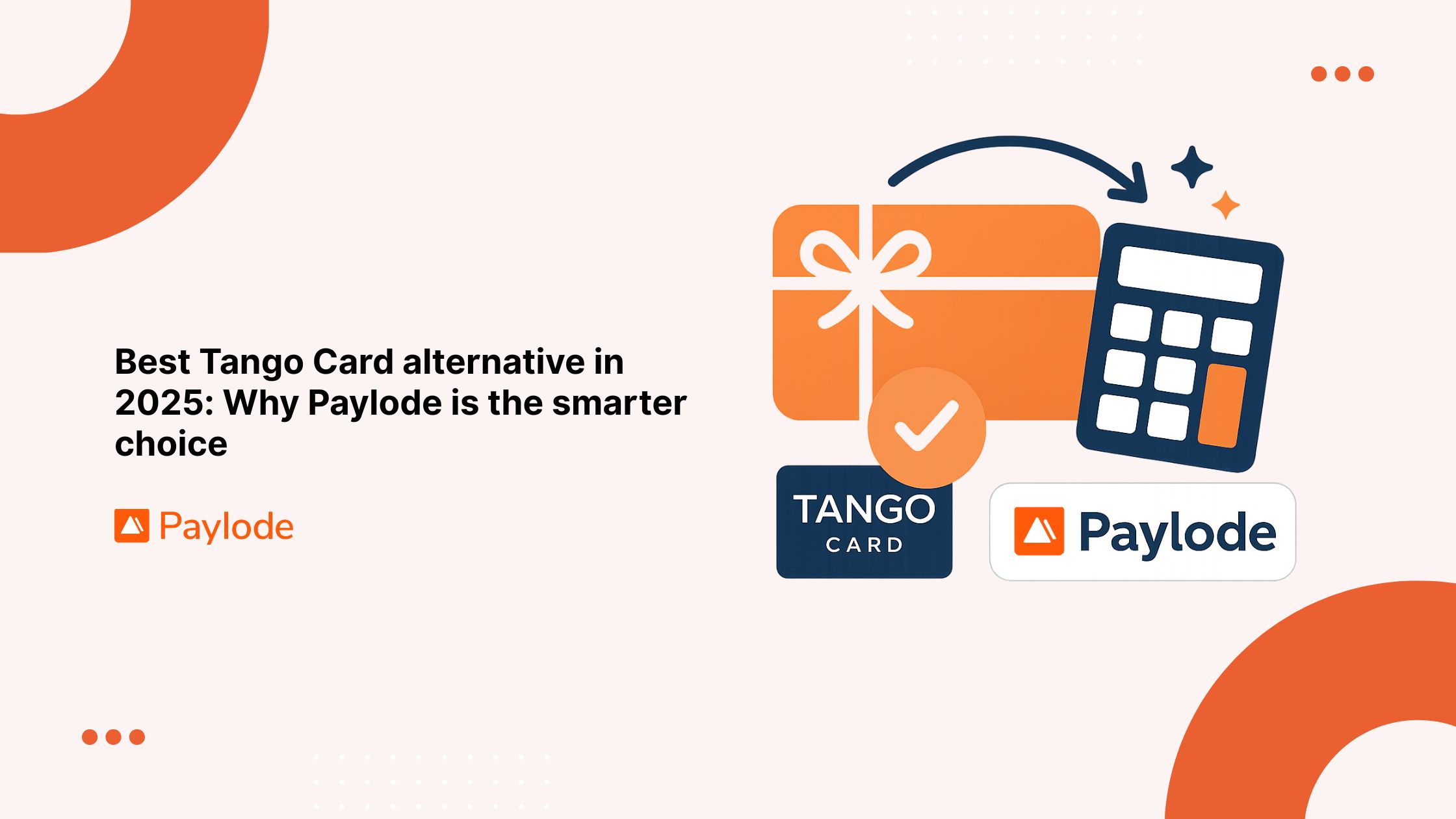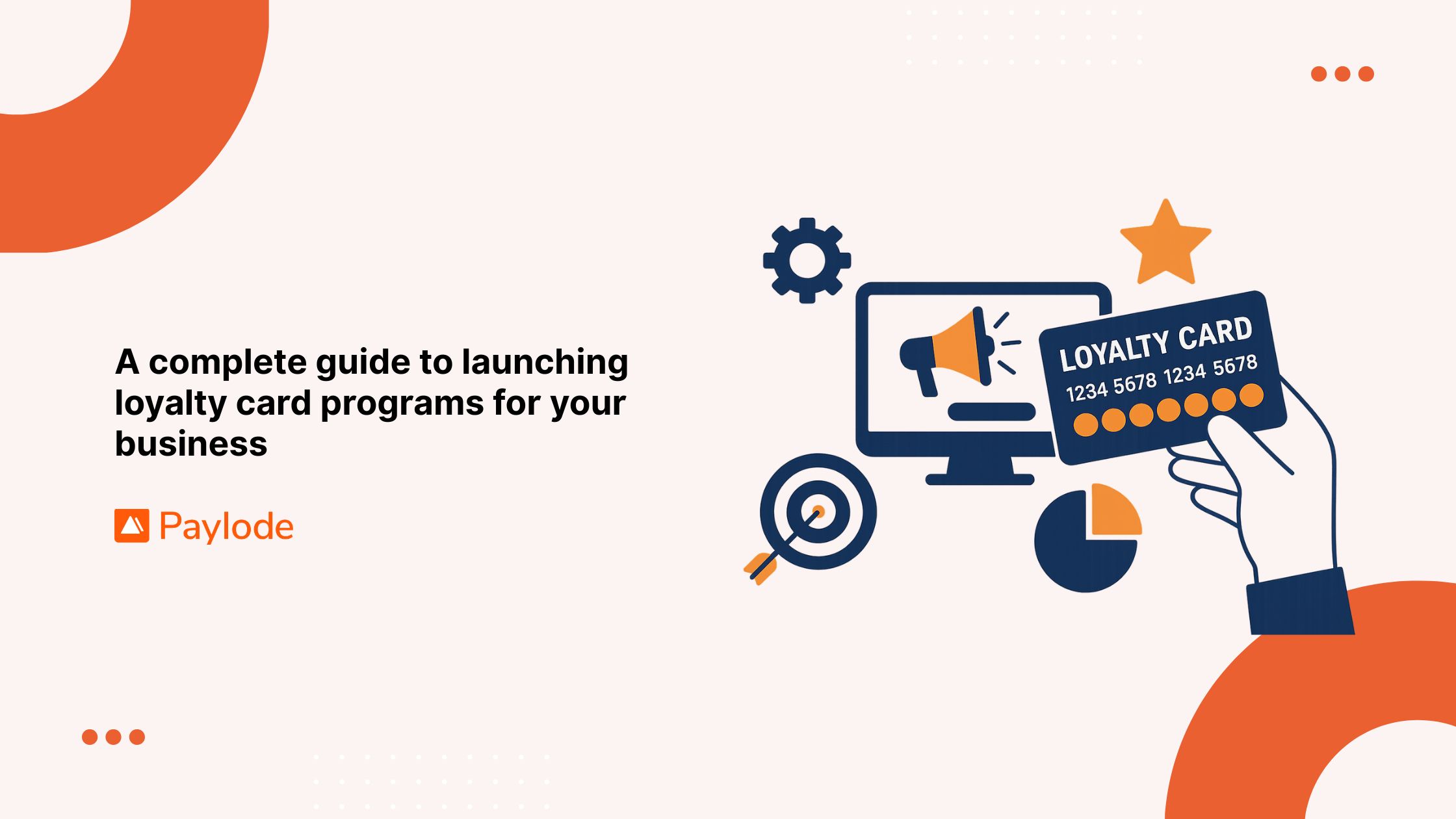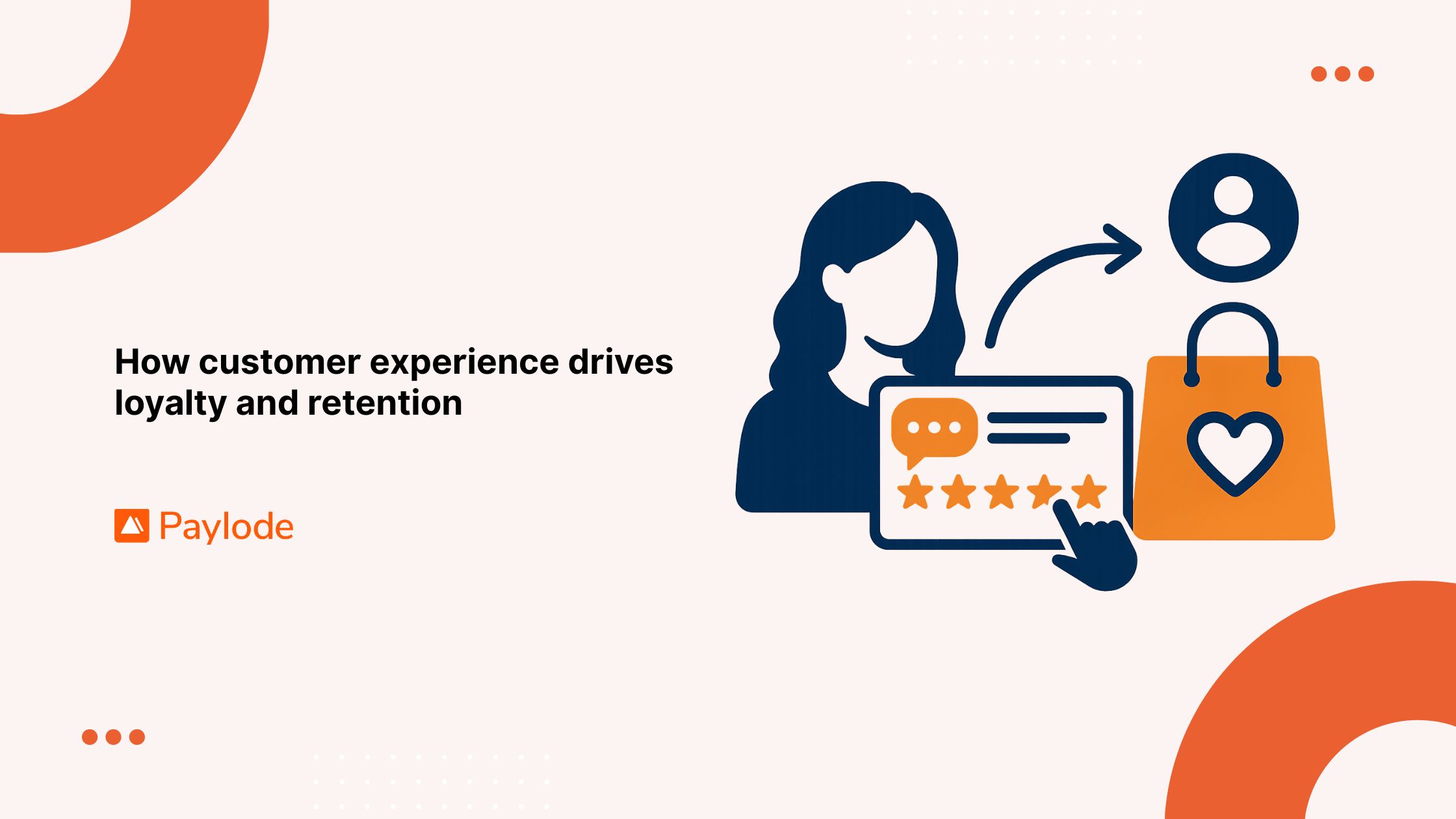Building customer loyalty is more crucial than ever, particularly in industries such as telecom, real estate, financial services, and digital health. But one big question remains for businesses: Should your loyalty program offer points or real rewards?
For years, companies have relied on loyalty points systems to keep users engaged. But today’s customers expect more—faster, clearer, and more personalized value. That’s where loyalty rewards come in.
At Paylode, we help brands move beyond outdated point systems by offering instant, real-world rewards that people care about. In this blog, we’ll break down the difference between loyalty points and rewards, explain why rewards work better for modern audiences, and show how real businesses are benefiting from this shift.
Whether you're a telecom provider, a property manager, or a financial service brand, this guide will help you rethink your approach to customer loyalty—with fewer friction points and better results.
What are loyalty points?
Loyalty points are a traditional way businesses try to reward customers. The idea is simple: customers earn points when they complete specific actions—such as making a purchase, paying a bill, or referring a friend. Over time, these points accumulate and can eventually be exchanged for discounts, products, or services.
How do loyalty point systems work?
Most point-based programs follow this model:
- A customer signs up for a loyalty program.
- They earn points for each qualifying activity (e.g., 1 point for every $1 spent).
- After collecting a certain number of points, they can redeem them for a reward.
- The redemption process usually requires logging into an account, checking point balances, and navigating a rewards catalog.
It’s a model that has been used by airlines, credit card companies, and retailers for decades. But while it may have worked in the past, it's not always effective in today’s experience-driven economy.
Common challenges with loyalty points
Despite being familiar, loyalty points come with several drawbacks that reduce their impact:
1. Delayed gratification
Customers often have to wait weeks or months to earn enough points to claim something meaningful. This delay creates a gap between the action and the reward, which weakens the emotional connection and reduces excitement.
2. Low redemption rates
According to industry data, a significant portion of loyalty points go unused. Customers either forget about them, don’t understand how to redeem them, or don’t think the reward is worth the effort.
3. Confusion and lack of transparency
Point systems often come with complex rules: expiration dates, minimum redemption thresholds, or limited reward options. This makes the experience frustrating instead of rewarding.
In short, while loyalty points were designed to drive engagement, they often do the opposite—leading to missed opportunities, wasted marketing dollars, and disengaged customers.
What are loyalty rewards?
Loyalty rewards are direct, meaningful benefits that customers receive immediately after completing a specific action. Unlike point systems, which delay the value, rewards offer instant gratification—a real incentive, delivered at the right time.
What do loyalty rewards look like?
Instead of asking customers to collect and manage points, loyalty rewards focus on delivering tangible value right away. Here are a few simple examples:
- A $10 voucher after signing up for a service
- A free month of premium access after referring a friend
- A discounted product or gift following a successful payment
- Access to exclusive perks or partner deals after enabling paperless billing
These rewards are easy to understand and exciting to receive—making them far more engaging than traditional point-based systems.
Key traits that make loyalty rewards effective
1. Instant gratification
When customers receive a reward immediately after taking action, they feel appreciated right away. This builds trust, reinforces positive behavior, and encourages repeat engagement.
2. Clear value
Unlike point systems that require math or guesswork, loyalty rewards are transparent. Customers know exactly what they’re getting and when, which makes the entire experience more satisfying.
3. Easier to promote and personalize
It’s easier to market a reward like “Get a $10 gift card today” than “Earn 200 points toward a future benefit.” Businesses can also tailor rewards to different user segments, making them more relevant and motivating.
With Paylode’s platform, businesses can launch real rewards across the customer journey—boosting engagement, increasing satisfaction, and improving retention without adding complexity.
Loyalty points vs rewards: A side-by-side comparison
To clearly understand why many modern businesses are shifting away from loyalty points, let’s compare points vs rewards across key factors that influence customer experience and business outcomes.
Why this matters
Customers today expect fast, easy, and personalized experiences. A confusing point-based system doesn’t align with those expectations. On the other hand, rewards are:
- Easy to understand
- Easy to communicate
- Easy to deliver
And that translates to higher engagement and stronger loyalty.
By simplifying the loyalty experience, rewards allow businesses to meet users where they are—and give them what they want, right when they want it.
Want to offer smarter, more personalized rewards? Learn more about how Paylode’s Perks can help you deliver real value.

Why loyalty rewards work better for today’s customers
Customer expectations have changed. Traditional loyalty systems—especially those built around points—don’t keep up with the habits and preferences of modern consumers. Today’s users want instant value, clear communication, and personalized experiences. Loyalty rewards deliver exactly that.
1. Gen Z and Millennials prefer instant and relevant experiences
Younger generations are highly responsive to instant incentives. They’ve grown up with digital platforms that deliver fast, personalized value—whether it’s a food delivery discount or an in-app bonus. Points that take weeks or months to accumulate feel outdated and unmotivating.
With loyalty rewards, businesses can meet these expectations by offering real benefits in real time—whether it’s a reward after an online purchase or a perk for enabling automatic payments.
2. Consumers value transparency and immediacy
One of the biggest frustrations with point-based systems is the lack of clarity. Customers often don’t know:
- How many points they have
- What they’re worth
- When they’ll expire
Loyalty rewards cut through the noise. When a customer sees “Get 20% off your next bill” or “Enjoy a $25 voucher today,” they immediately understand the value. This builds trust and encourages repeat behavior.
3. Businesses see higher engagement and ROI
From increased click-through rates to stronger retention, reward-based programs consistently outperform points-based ones in metrics that matter. Businesses that use reward-driven experiences report measurable gains in:
- Activation rates
- Customer satisfaction
- Conversion rates
- Customer lifetime value
For example, Elevate Mobile boosted ARPU by 19% in just 90 days by offering meaningful rewards tied to customer actions—without relying on complex point systems.
4. Rewards can be tailored to customer behavior
Another key advantage of loyalty rewards is flexibility. You can match a reward to:
- A new user who just signed up
- A loyal customer who’s about to churn
- A user who enabled paperless billing
- A subscriber who referred a friend
This behavior-based targeting creates a much stronger emotional impact—and drives the kind of loyalty that lasts.
Whether you're in residential real estate, telecom, or digital health, the need for modern, reward-driven engagement is the same: customers respond better when the value is real, instant, and personal.
Real-world impact: What businesses gain with reward-based loyalty
Shifting from points to real rewards isn’t just a trend—it’s a proven strategy that delivers measurable results across industries. Businesses that adopt reward-based loyalty programs see improvements in customer engagement, retention, and revenue—all while gaining better insights into what their users actually care about.
1. Increased customer retention
Customers are far more likely to stay loyal when they feel appreciated—and nothing communicates appreciation like an instant reward. When users receive tangible value right after an action, it creates a positive feedback loop. They’re more likely to return, repeat the action, and build a long-term relationship with your brand.
This is especially true in competitive industries like telecom and internet services, where MVNOs have cut churn by 28% with Paylode by offering timely, relevant rewards instead of generic point systems.
2. Higher conversion rates from campaigns
When customers know exactly what they’ll get—whether it’s a $10 reward for signing up or a special perk for switching to paperless—they’re more likely to act. Compared to point-based programs, reward campaigns tend to drive:
- Higher email open and click-through rates
- Better activation rates
- More successful upsell and cross-sell opportunities
That’s because clarity and immediacy drive action. There's no guesswork—just clear incentives tied to valuable behaviors.
3. Better data on what customers truly value
With point systems, it’s hard to know which rewards are meaningful to your audience. But when you offer different reward types (gift cards, discounts, subscriptions, etc.) and track redemptions, you gather powerful insights:
- What reward types generate the most engagement?
- Which actions lead to high-value conversions?
- How do customer preferences vary across segments?
This helps your team continuously optimize the loyalty experience—without relying on assumptions.
4. Stronger brand loyalty through meaningful interactions
When a reward feels personalized and timely, it creates a connection that goes beyond transactions. Instead of waiting for points to add up, customers feel seen and valued in the moment. This builds a deeper emotional bond—the kind that leads to advocacy, not just retention.
For instance, one Paylode client boosted digital engagement through reward-based loyalty, proving that real rewards don’t just convert—they create loyal brand champions.
Whether you’re serving financial services customers or managing large tenant communities, reward-based loyalty creates real business impact—without the complexity of points.
How Paylode helps you deliver real rewards, not points
At Paylode, we believe loyalty shouldn’t be complicated—for your customers or your business. That’s why we’ve built a platform designed to make reward-based loyalty easy, flexible, and impactful from day one.
Here’s how we help you move away from points and start delivering real rewards your customers will love.
1. Plug-and-play rewards catalog
Our extensive pre-built catalog of perks and offers gives you access to a wide range of high-value rewards—ready to go live without any heavy lifting. From top-brand gift cards to exclusive discounts, you can instantly add rewards that match your audience and your business goals.
With options for resident perks, billing incentives, digital engagement, and more, you’ll always have the right reward at the right moment.
2. Personalized reward journeys
Paylode makes it simple to build custom reward flows across the customer lifecycle:
- Welcome new users with a sign-up reward
- Offer a perk when customers enable automatic payments
- Incentivize switching to paperless
- Reward referrals or app feature adoption
Our system lets you tailor rewards based on customer behavior, lifecycle stage, or industry needs—whether you’re in Telecom, ISPs, or digital health loyalty software.
3. No complex point system needed
Forget about building, managing, and maintaining a points engine. With Paylode, you don’t need to worry about point expiration, conversions, or tracking balances. Instead, our platform focuses on direct actions and real outcomes—saving your team time while improving the customer experience.
4. Seamless integrations and scalable results
Paylode works with your existing tech stack—whether that’s a CRM, marketing platform, or billing system. You can plug in reward journeys where they make sense, and scale them as your user base grows.
Already, brands like Elevate Mobile and several MVNOs have seen major success with Paylode’s solutions. Just explore our Boost platform or learn how to get started on our plans page to see how easy it is to roll out reward-based loyalty at scale.
Looking to engage your users and increase lifetime value? Paylode's reward-based system delivers better outcomes—without the complications of points.
Is it time to rethink your loyalty program?
Many businesses stick with point-based loyalty programs simply because they’re familiar. But in today’s experience-driven economy, that approach might be costing you more than you think—in engagement, conversions, and long-term loyalty.
To decide whether it’s time for a change, ask yourself these critical questions:
1. Are your customers actually redeeming points?
If redemption rates are low or stagnant, it’s a clear sign the system isn’t resonating. Points that sit unused don’t deliver value—for your customers or your business. Worse, they can create frustration or confusion.
Reward-based programs, on the other hand, deliver instant value and typically see much higher redemption rates.
2. Do customers understand the value of your loyalty program?
If your users aren’t sure how many points they have, what they’re worth, or how to use them, the perceived value drops. Complexity kills engagement.
With real rewards, value is simple and transparent. When a customer sees “Get $15 off your next purchase,” they know exactly what they’re getting and how to use it.
3. Are you rewarding customer behavior instantly?
Behavioral science shows that immediate rewards are more effective at reinforcing action. If you wait too long between the action (like a sign-up or payment) and the reward, the emotional impact fades—and the habit doesn’t stick.
Paylode enables you to deliver rewards in real time, so your customers feel recognized and valued the moment they take action.
If you answered “no” to any of the above questions, it’s a clear sign that your loyalty strategy might need an upgrade.
Ready to evolve your loyalty program and offer rewards that drive growth? Explore our platform and see how simple it can be.
Conclusion
Loyalty programs are no longer just a “nice to have”—they’re a key part of how businesses build long-term relationships with their customers. But not all loyalty programs are created equal.
Loyalty points, while once popular, often fall short in today’s fast-paced, customer-first world. They delay value, create confusion, and lead to low engagement.
Loyalty rewards, on the other hand, offer:
- Instant, clear value
- Higher engagement and redemption rates
- A better experience for customers
- Stronger business outcomes—measured in retention, satisfaction, and revenue
At Paylode, we help forward-thinking businesses deliver real rewards, not points. Whether you’re in telecom, real estate, finance, or any other industry, our platform gives you everything you need to build a loyalty experience that works—without the complexity.
You don’t need to build a points system. You don’t need to guess what your customers want. You just need a platform that delivers value where it matters most—at the moment of action.
Frequently asked questions
1. Why are loyalty rewards better than loyalty points?
Loyalty rewards provide instant and clear value to customers, while points often require waiting, tracking, and redeeming through complex systems. Customers are more likely to engage with programs that offer real rewards they can use right away.
2. Will customers still be loyal without a points system?
Yes. Customers are more loyal when they feel recognized and rewarded at the right time. Real rewards—like discounts, gift cards, or perks—create positive moments that build trust and long-term relationships.
3. Can I personalize rewards based on customer behavior?
Absolutely. With platforms like Paylode, you can offer rewards tailored to specific actions—such as paying a bill, signing up, or switching to paperless—making each interaction more relevant and valuable to the customer.
4. Is it hard to switch from points to a reward-based system?
Not at all. Paylode makes the transition simple with a plug-and-play reward catalog, built-in integrations, and flexible options for different use cases. You don’t need to rebuild your system—just plug in rewards where they make the most impact.
5. What kind of rewards do customers respond to best?
Customers respond best to rewards that are immediate, relevant, and easy to use. These include digital gift cards, discounts, subscription bonuses, or access to exclusive offers. The key is to match the reward to the user’s action and preferences.


